Enhancing Reinforced Concrete Beams: Investigating Steel Dust as a Cement Substitute
Abstract
:1. Introduction
2. Materials and Methods
2.1. Sieve Analysis
2.2. Mix Design
2.3. Casting
2.4. Reinforced Concrete Beams Details
2.5. Experimental Testing
3. Results and Discussion
3.1. Workability
3.2. Density
3.3. Elastic Modulus
3.4. Compressive Strength
3.5. Ultrasonic Pulse Velocity (UPV)
3.6. Split Tensile Strength
3.7. Flexural Strength
3.8. Load-Deflection Curve for Beams
3.9. Beams’ Strain Distribution
3.10. Damage Pattern of the Beams
- The examination and analysis of crack patterns in the tested beams constitute a vital component of the study, offering valuable insights into the ductility and failure mechanisms of concrete elements subjected to bending loads. The results, as presented in Figure 21, provide essential information about how different levels of cement replacement by steel dust influence crack formation and propagation.
- Notably, the beam designated as SD10 exhibited the highest level of ductility among the tested samples. This is evidenced by the larger number of microcracks observed in comparison to the control beam (SD0) and the beams with 20% (SD20) and 30% (SD30) cement replacement by steel dust. The presence of more microcracks in the SD10 beam signifies its ability to withstand a greater degree of deformation before reaching failure. This characteristic is indicative of an increased level of energy absorption capacity, which is a critical factor in the design of structural elements. Elevated ductility can enhance the overall performance and safety of a structure, especially in scenarios where structures are exposed to dynamic or seismic forces.
- It is worth noting that these findings align with prior research that has explored the enhancement of ductility in reinforced concrete beams through the incorporation of alternative materials. For example, studies involving the use of bottom ash and waste marble powder have also demonstrated improvements in ductility [60,63,64]. These consistent findings highlight the potential for various waste and alternative materials to contribute to the ductility and overall performance of reinforced concrete structures, offering sustainable solutions in construction engineering.
4. Conclusions
- The assessment of concrete mix workability indicated a 20% reduction in workability and a 4.3% decrease in density with increasing steel dust content, as determined by the slump test. Concurrently, variations in the elasticity modulus were observed, with a 10% increase at 10% steel dust replacement and an 18% decrease at 30% steel dust replacement compared to the control mix. In response to these findings, modified equations for the modulus of elasticity were introduced for mixes incorporating steel dust as a cement substitute.
- The compressive strength exhibited an upward trend at a 10% cement replacement but experienced a decline at both 20% and 30% replacements. These trends were paralleled by the ultrasonic-pulse velocity tests. Similarly, the split tensile and flexural strength tests demonstrated enhancements at the 10% replacement level but exhibited reductions at the 30% replacement level. In response to these observations, modified equations were formulated to account for these variations in strength properties.
- The study revealed that replacing 10% of the cement with steel dust as a substitution improved the ductility of concrete beams, resulting in a 13% increase in the ductility ratio and a 5% higher maximum load compared to the control mix. Conversely, substituting 30% of the cement with steel dust had adverse effects, leading to a reduced ductility ratio by 44% and a decrease in maximum load by 18% in comparison to the control mix.
- The SD10 beam (with 10% SD as cement replacement) exhibited fewer microcracks and greater deformation resistance, sustaining a 20 kN load without yielding, while the other beams yielded under the same load conditions.
Author Contributions
Funding
Data Availability Statement
Conflicts of Interest
References
- Jahami, A.; Khatib, J.; Raydan, R. Production of Low-Cost, High-Strength Concrete with Waste Glass as Fine Aggregates Replacement. Buildings 2022, 12, 2168. [Google Scholar] [CrossRef]
- Jahami, A.; Issa, C.A. Exploring the Use of Mixed Waste Materials (MWM) in Concrete for Sustainable Construction: A Review. Constr. Build. Mater. 2023, 398, 132476. [Google Scholar] [CrossRef]
- Ramadan, R.; Jahami, A.; Khatib, J.; El-Hassan, H.; Elkordi, A. Improving Structural Performance of Reinforced Concrete Beams with Phragmites Australis Fiber and Waste Glass Additives. Appl. Sci. 2023, 13, 4206. [Google Scholar] [CrossRef]
- Khatib, J.; Jahami, A.; Baalbaki, O. Flexural Characteristics of Reinforced Concrete Beams Containing Lightweight Aggregate in the Tensile Zone. Sustain. Constr. Mater. Technol. 2019. [Google Scholar] [CrossRef]
- Raydan, R.; Khatib, J.; Jahami, A.; El Hamoui, A.K.; Chamseddine, F. Prediction of the Mechanical Strength of Concrete Containing Glass Powder as Partial Cement Replacement Material. Innov. Infrastruct. Solut. 2022, 7, 311. [Google Scholar] [CrossRef]
- Dhir, R.K.; Jackson, N. Civil Engineering Materials, 5th ed.; Macmillan Press Ltd.: London, UK, 1996. [Google Scholar]
- Liu, T.; Nafees, A.; Khan, S.; Javed, M.F.; Aslam, F.; Alabduljabbar, H.; Xiong, J.-J.; Khan, M.I.; Malik, M.Y. Comparative Study of Mechanical Properties between Irradiated and Regular Plastic Waste as a Replacement of Cement and Fine Aggregate for Manufacturing of Green Concrete. Ain Shams Eng. J. 2022, 13, 101563. [Google Scholar] [CrossRef]
- Salem, S.; Hamdy, Y.; Abdelraouf, E.-S.; Shazly, M. Towards Sustainable Concrete: Cement Replacement Using Egyptian Cornstalk Ash. Case Stud. Constr. Mater. 2022, 17, e01193. [Google Scholar] [CrossRef]
- Luo, T.; Hua, C.; Liu, F.; Sun, Q.; Yi, Y.; Pan, X. Effect of Adding Solid Waste Silica Fume as a Cement Paste Replacement on the Properties of Fresh and Hardened Concrete. Case Stud. Constr. Mater. 2022, 16, e01048. [Google Scholar] [CrossRef]
- Arif, R.; Khitab, A.; Kırgız, M.S.; Khan, R.B.N.; Tayyab, S.; Khan, R.A.; Anwar, W.; Arshad, M.T. Experimental Analysis on Partial Replacement of Cement with Brick Powder in Concrete. Case Stud. Constr. Mater. 2021, 15, e00749. [Google Scholar] [CrossRef]
- Taylor, P.; Yurdakul, E.; Brink, M. Performance-Based Proportioning: Designing Concrete Mixtures for Specific Performance Requirements. Concr. Int. 2015, 37, 41–46. [Google Scholar]
- Aiken, T.A.; Kwasny, J.; Russell, M.; McPolin, D.; Bagnall, L. Effect of Partial Mgo Replacement on the Properties of Magnesium Oxychloride Cement. Cem. Concr. Compos. 2022, 134, 104791. [Google Scholar] [CrossRef]
- Hussain, I.; Ali, B.; Rashid, M.U.; Amir, M.T.; Riaz, S.; Ali, A. Engineering Properties of Factory Manufactured Paving Blocks Utilizing Steel Slag as Cement Replacement. Case Stud. Constr. Mater. 2021, 15, e00755. [Google Scholar] [CrossRef]
- Duan, P.; Shui, Z.; Chen, W.; Shen, C. Enhancing microstructure and durability of concrete from ground granulated blast furnace slag and metakaolin as cement replacement materials. J. Mater. Res. Technol. 2013, 2, 52–59. [Google Scholar] [CrossRef]
- Al-Swaidani, A.M. Experimental data on permeability-related properties of concrete containing nano natural pozzolana as cement replacement. Data Brief 2022, 43, 108391. [Google Scholar] [CrossRef] [PubMed]
- Ahmad, S.I.; Ahmed, Z.B.; Ahmed, T. Feasibility of sludge generated in water-based paint industries as cement replacement material. Case Stud. Constr. Mater. 2022, 16, e01119. [Google Scholar] [CrossRef]
- Brekailo, F.; Pereira, E.; Pereira, E.; Farias, M.M.; Medeiros-Junior, R.A. Red ceramic and concrete waste as replacement of Portland cement: Microstructure aspect of eco-mortar in external sulfate attack. Clean. Mater. 2022, 3, 100034. [Google Scholar] [CrossRef]
- Saidi, T.; Hasan, M. The effect of partial replacement of cement with diatomaceous earth [DE] on the compressive strength and absorption of mortar. J. King Saud Univ.-Eng. Sci. 2022, 34, 250–259. [Google Scholar] [CrossRef]
- Chowdhury, S.; Mishra, M.; Suganya, O. The incorporation of wood waste ash as a partial cement replacement material for making structural grade concrete: An overview. Ain Shams Eng. J. 2015, 6, 429–437. [Google Scholar] [CrossRef]
- Nassar, R.U.D.; Soroushian, P.; Sufyan-Ud-Din, M. Long-term field performance of concrete produced with powder waste glass as partial replacement of cement. Case Stud. Constr. Mater. 2021, 15, e00745. [Google Scholar] [CrossRef]
- Ahdal, A.Q.; Amrani, M.A.; Ghaleb, A.A.A.; Abadel, A.A.; Alghamdi, H.; Alamri, M.; Wasim, M.; Shameeri, M. Mechanical performance and feasibility analysis of green concrete prepared with local natural zeolite and waste PET plastic fibers as cement replacements. Case Stud. Constr. Mater. 2022, 17, e01256. [Google Scholar] [CrossRef]
- Ibrahim, K.I.M. Recycled waste glass powder as a partial replacement of cement in concrete containing silica fume and fly ash. Case Stud. Constr. Mater. 2021, 15, e00630. [Google Scholar] [CrossRef]
- Zhang, W.; Gu, X.; Qiu, J.; Liu, J.; Zhao, Y.; Li, X. Effects of iron ore tailings on the compressive strength and permeability of ultra-high performance concrete. Constr. Build. Mater. 2020, 260, 119917. [Google Scholar] [CrossRef]
- Satyaprakasha, P.H.; Sainia, S. Mechanical properties of concrete in presence of iron filings as complete replacement of fine aggregates. Mater. Today: Proc. 2018, 5, 20552–20561. [Google Scholar] [CrossRef]
- Alzaed, A.N. Effect of Iron Filings in Concrete Compression and Tensile Strength. Int. J. Recent Dev. Eng. Technol. 2014, 3, 121–125. [Google Scholar]
- Olutoge, F.A.; Onugba, M.A.; Ocholi, A. Strength Properties of Concrete Produced with Iron Filings as Sand Replacement. Br. J. Appl. Sci. Technol. 2017, 18, 1–6. [Google Scholar] [CrossRef]
- Cheng, Y.; Huang, F.; Qi, S.; Li, W.; Liu, R.; Li, G. Durability of concrete incorporated with siliceous iron tailings. Constr. Build. Mater. 2020, 242, 118147. [Google Scholar] [CrossRef]
- Ali, A.; Elkanzi, M.H.A. The effect of replacements 30% for each concrete component by iron filling in concrete on attenuation properties. Int. J. Res. Eng. Technol. 2015, 4, 145–149. [Google Scholar] [CrossRef]
- Parron-Rubio, M.E.; Kissi, B.; Perez-García, F.; Rubio-Cintas, M.D. Development in sustainable concrete with the replacement of fume dust and slag from the steel industry. Materials 2022, 15, 5980. [Google Scholar] [CrossRef]
- Eren, Ö.; Marar, K. Effects of limestone crusher dust and steel fibers on concrete. Constr. Build. Mater. 2009, 23, 981–988. [Google Scholar] [CrossRef]
- Ajwad, A.; Abdullah; Usman, M.; Ahmad, S.; Ilyas, U.; Akhtar, A.W.; Zahid, B. Enhancing concrete properties by adding shred-like steel fibers and steel dust. Sci. Inquiry Rev. 2019, 3, 55–68. [Google Scholar] [CrossRef]
- Shelorkar, A.P.; Malode, A.; Loya, A. Experimental investigation on steel fibre reinforcedconcrete using metakaolin. Int. J. Struct. Civ. Eng. 2013, 2, 96–100. [Google Scholar]
- Shukla, A.; Gupta, N.; Kishore, K. Experimental investigation on the effect of steel fiber embedded in marble dust based concrete. Mater. Today Proc. 2020, 26, 2938–2945. [Google Scholar] [CrossRef]
- Maharajan, A.; Bansal, R.S.; Kumar, A.; Mehta, K. Structural Behaviour of Plain Cement Concrete with Marble Dust Powder and Steel Fiber. Int. J. Mod. Trends Eng. Res. 2018, 5, 37–48. [Google Scholar] [CrossRef]
- Aghaee, K.; Yazdi, M.A.; Tsavdaridis, K.D. Investigation into the mechanical properties of structural lightweight concrete reinforced with waste steel wires. Mag. Concr. Res. 2015, 67, 197–205. [Google Scholar] [CrossRef]
- Aslani, F.; Gedeon, R. Experimental investigation into the properties of self-compacting rubberised concrete incorporating polypropylene and steel fibers. Struct. Concr. 2019, 20, 267–281. [Google Scholar] [CrossRef]
- Shaaban, I.G.; Rizzuto, J.P.; El-Nemr, A.; Bohan, L.; Ahmed, H.; Tindyebwa, H. Mechanical Properties and Air Permeability of Concrete Containing Waste Tyres Extracts. J. Mater. Civ. Eng. 2021, 33, 04020472. [Google Scholar] [CrossRef]
- Karalar, M.; Özkılıç, Y.O.; Deifalla, A.F.; Aksoylu, C.; Arslan, M.H.; Ahmad, M.; Sabri, M.M.S. Improvement in Bending Performance of Reinforced Concrete Beams Produced with Waste Lathe Scraps. Sustainability 2022, 14, 12660. [Google Scholar] [CrossRef]
- Çelik, A.İ.; Özkılıç, Y.O.; Zeybek, Ö.; Özdöner, N.; Tayeh, B.A. Performance Assessment of Fiber-Reinforced Concrete Produced with Waste Lathe Fibers. Sustainability 2022, 14, 11817. [Google Scholar] [CrossRef]
- Zeybek, Ö.; Özkılıç, Y.O.; Çelik, A.İ.; Deifalla, A.F.; Ahmad, M.; Sabri Sabri, M.M. Performance evaluation of fiber reinforced concrete produced with steel fibers extracted from waste tire. Front. Mater. 2022, 9, 1057128. [Google Scholar] [CrossRef]
- Waziri, B.S.; Mohammed, A.; Bukar, A.G. Effect of water-cement ratio on the strength properties of Quarry-Sand Concrete. Cont. J. Eng. Sci. 2011, 6, 16–21. [Google Scholar]
- Kazjonovs, J.; Bajāre, D.; Korjakins, A. Designing of High Density Concrete by Using Steel Treatment Waste. Mod. Build. Mater. Struct. Technol. 2010, 138–142. [Google Scholar]
- Kalpana, M.; Tayu, A. Experimental Investigation on Lightweight Concrete Added with Industrial Waste (Steel Waste). Mater. Today Proc. 2020, 22, 887–889. [Google Scholar] [CrossRef]
- Peng, Q.; Chen, B.; Lü, Q.; Li, K.; Jin, W. Effect of Steel-Waste PET Hybrid Fiber on Properties of Recycled Aggregate Concrete Based on Response Surface Methodology. Constr. Build. Mater. 2023, 397, 132448. [Google Scholar] [CrossRef]
- Kangu, A.N.; Shitote, S.M.; Onchiri, R.O.; Matallah, M. Effects of Waste Tyre Steel Fibres on the Ultimate Capacity of Headed Studs in Normal Concrete. Case Stud. Constr. Mater. 2023, 18, e02166. [Google Scholar] [CrossRef]
- Shewalul, Y.W. Experimental Study of the Effect of Waste Steel Scrap as Reinforcing Material on the Mechanical Properties of Concrete. Case Stud. Constr. Mater. 2021, 14, e00490. [Google Scholar] [CrossRef]
- Centonze, G.; Leone, M.; Aiello, M.A. Steel Fibers from Waste Tires as Reinforcement in Concrete: A Mechanical Characterization. Constr. Build. Mater. 2012, 36, 46–57. [Google Scholar] [CrossRef]
- BS EN 12390-2; Testing Hardened Concrete Making and Curing Specimens for Strength Tests. BSI: London, UK, 2009.
- B.S. EN, 12350-12352; Testing Fresh Concrete Slump-Test. BSI: London, UK, 2009.
- B.S. EN, 12350-12356; Testing Fresh Concrete Density. BSI: London, UK, 2009.
- B.S. EN, 12504-4; Testing Concrete. Determination of Ultrasonic Pulse Velocity. BSI: London, UK, 2004.
- B.S. EN, 12390-12393; Testing Hardened Concrete-Part 3: Compressive Strength of Test Specimens. BSI: London, UK, 2002.
- BS EN 12390-4; Testing Hardened Concrete—Compressive Strength. Specification for Testing Machines. BSI: London, UK, 2019.
- B.S. EN, 12390-12396; Testing Hardened Concrete-Part 6: Tensile Splitting Strength of Test Specimens. BSI: London, UK, 2009.
- B.S. EN, 12390-13; Testing Hardened Concrete–Part 13: Determination of Secant Modulus of Elasticity in Compression. BSI: London, UK, 2013.
- Khatib, J.; Jefimiuk, A.; Khatib, S. Flexural behaviour of reinforced concrete Beams containing expanded glass as Lightweight aggregates. Slovak J. Civ. Eng. 2015, 23, 1–7. [Google Scholar] [CrossRef]
- S. EN, 12390–12395; Testing Hardened Concrete–Part 5: Flexural Strength of Test Specimens. BSI: London, UK, 2009.
- Shettima, A.U.; Hussin, M.W.; Ahmad, Y.; Mirza, J. Evaluation of iron ore tailings as replacement for fine aggregate in concrete. Constr. Build. Mater. 2016, 120, 72–79. [Google Scholar] [CrossRef]
- Zeybek, Ö.; Özkılıç, Y.O.; Karalar, M.; Çelik, A.İ.; Qaidi, S.; Ahmad, J.; Burduhos-Nergis, D.D.; Burduhos-Nergis, D.P. Influence of Replacing Cement with Waste Glasson Mechanical Properties of Concrete. Materials 2022, 15, 7513. [Google Scholar] [CrossRef]
- Karalar, M.; Özkılıç, Y.O.; Aksoylu, C.; Sabri Sabri, M.M.; Beskopylny, A.N.; Stel’makh, S.A.; Shcherban’, E.M. Flexural behavior of reinforced concrete beams using waste marble powder towards application of sustainable concrete. Front. Mater. 2022, 9, 1068791. [Google Scholar] [CrossRef]
- Hassiba, B.; Mekki, M.; Fraid, R. The relationship between the compressive strength and ultrasonic pulse velocity concrete with fibers exposed to high temperatures. Appl. Energet. Pollut. 2016, 3, 31–36. [Google Scholar] [CrossRef]
- ACI Committee 318. Building Code Requirements for Structural Concrete: (ACI 318-19) and Commentary (ACI 318R-19); American Concrete Institute: Farmington Hills, MI, USA, 1995. [Google Scholar]
- Karalar, M.; Bilir, T.; Çavuşlu, M.; Özkiliç, Y.O.; Sabri Sabri, M.M. Use of recycled coal bottom ash in reinforced concrete beams as replacement for aggregate. Front. Mater. 2022, 9, 1064604. [Google Scholar] [CrossRef]
- Aksoylu, C.; Özkılıç, Y.O.; Hadzima-Nyarko, M.; I¸sık, E.; Arslan, M.H. Investigation on Improvement in Shear Performance of Reinforced-Concrete Beams Produced with Recycled Steel Wires from Waste Tires. Sustainability 2022, 14, 13360. [Google Scholar] [CrossRef]
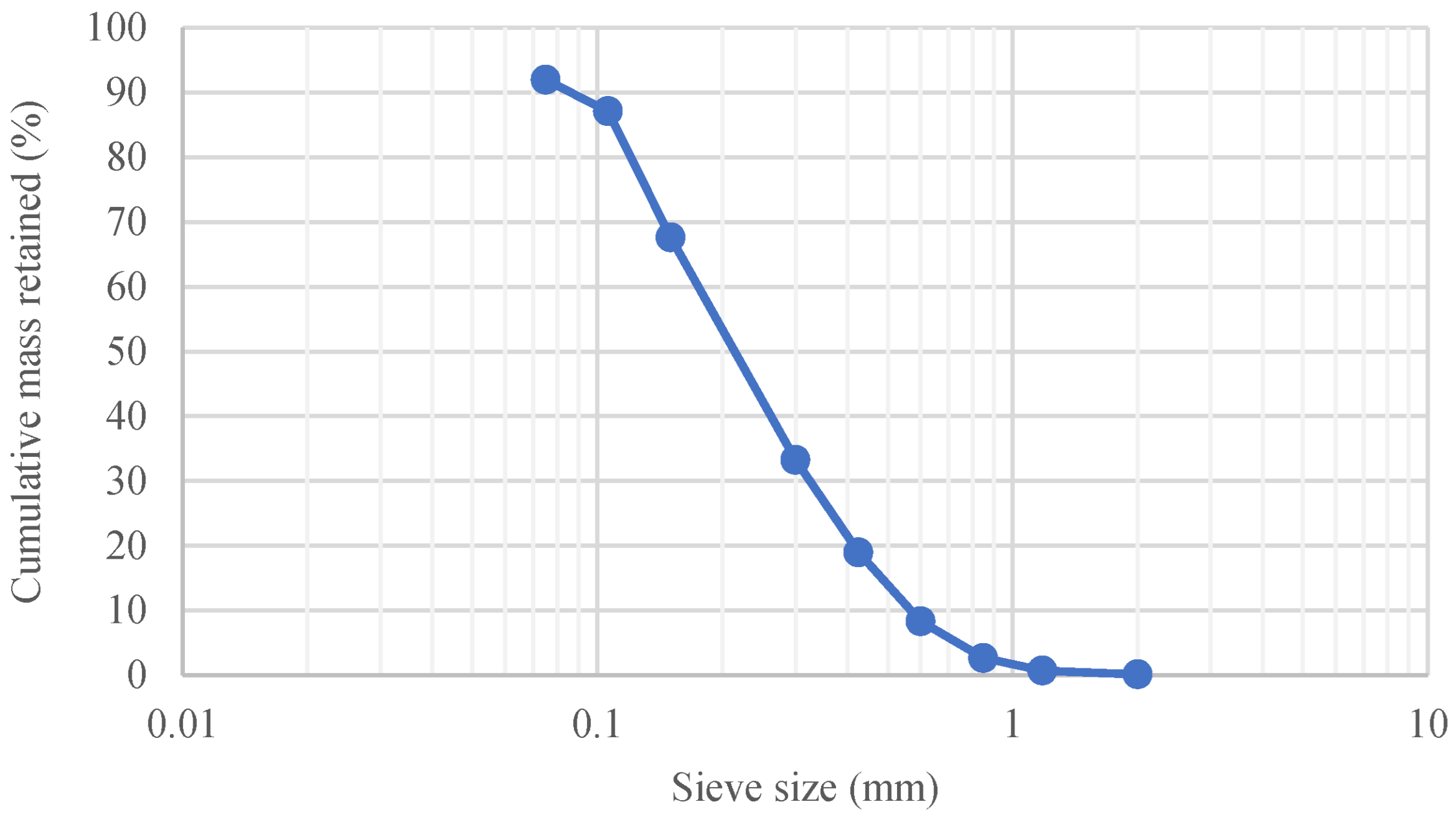
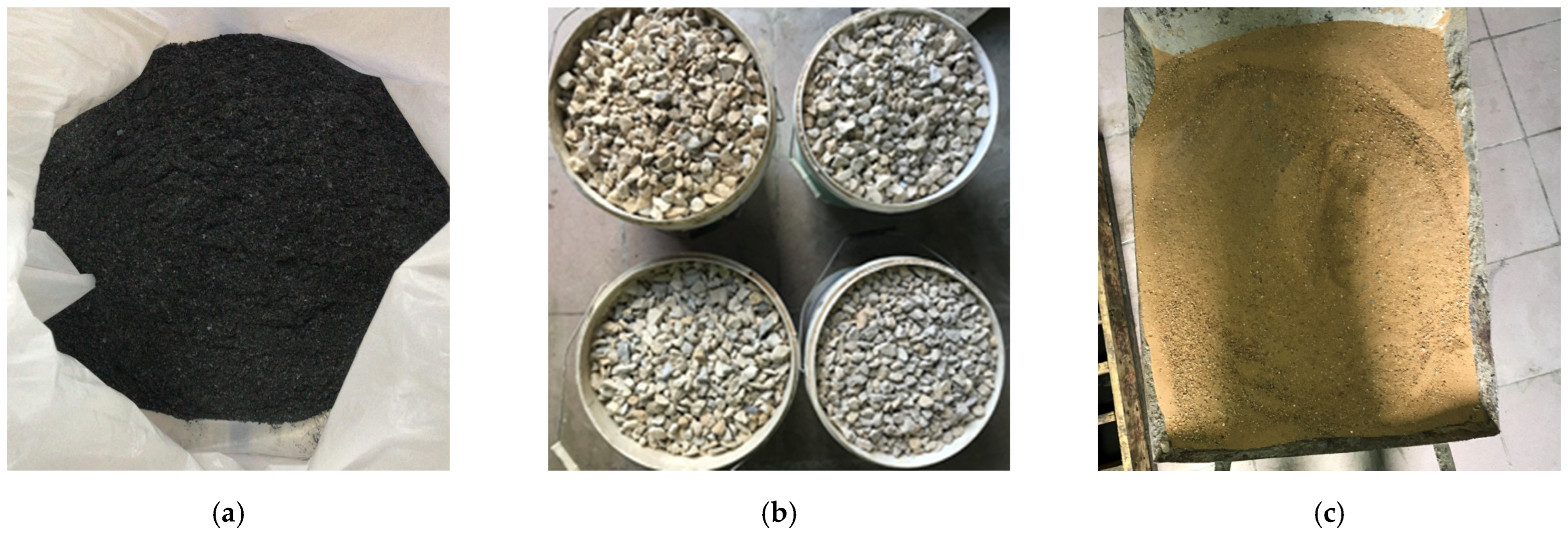
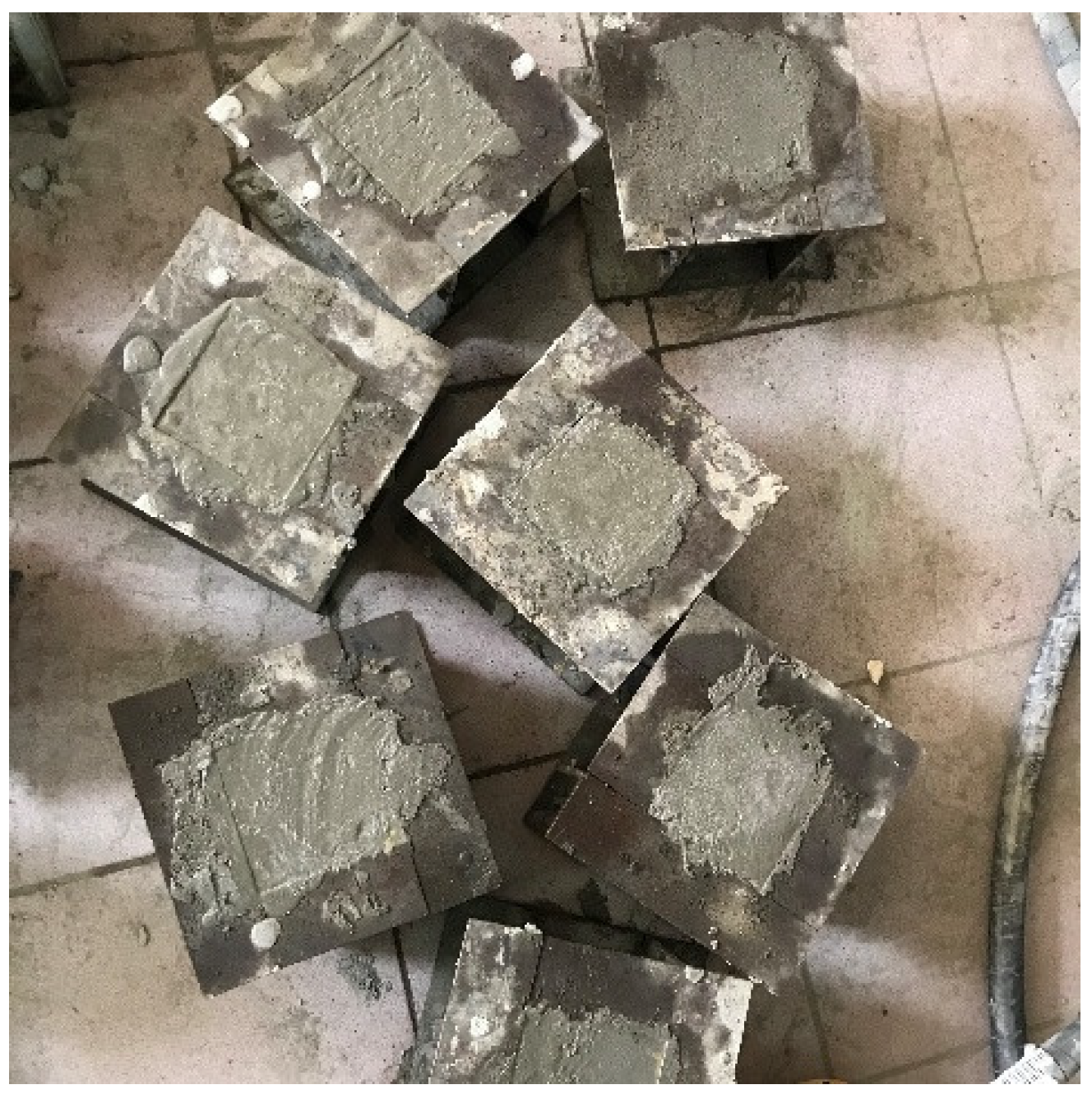
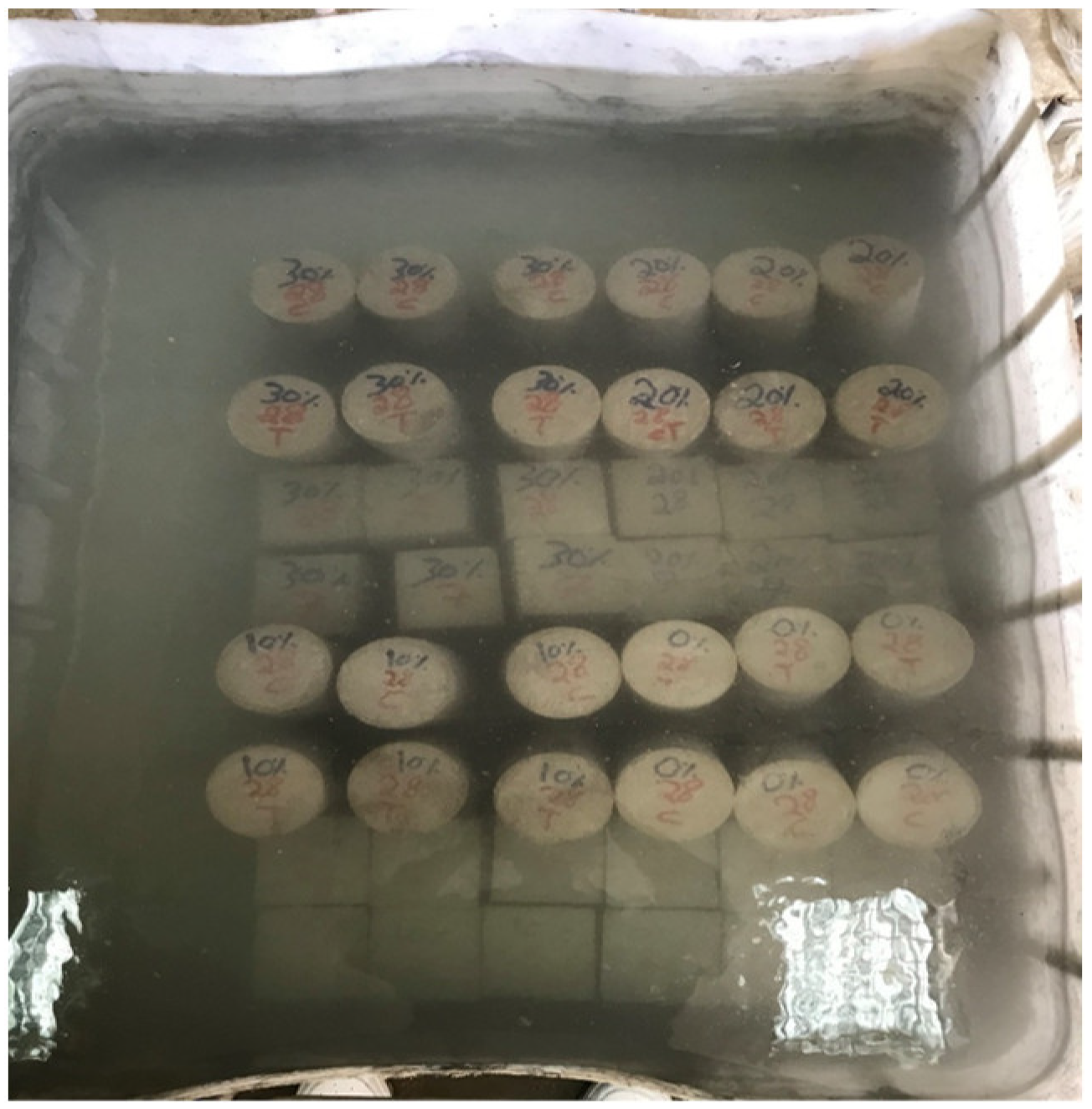
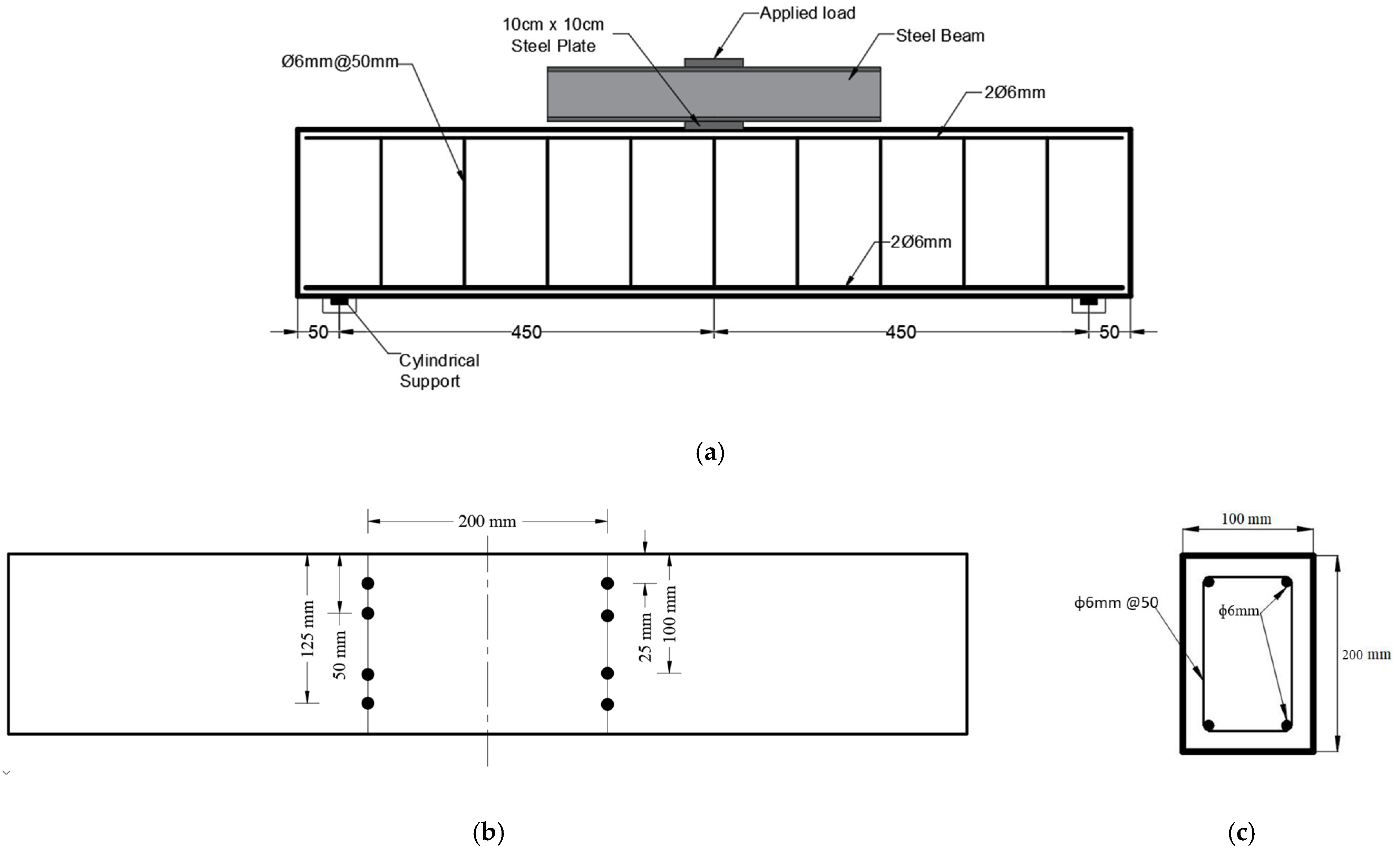


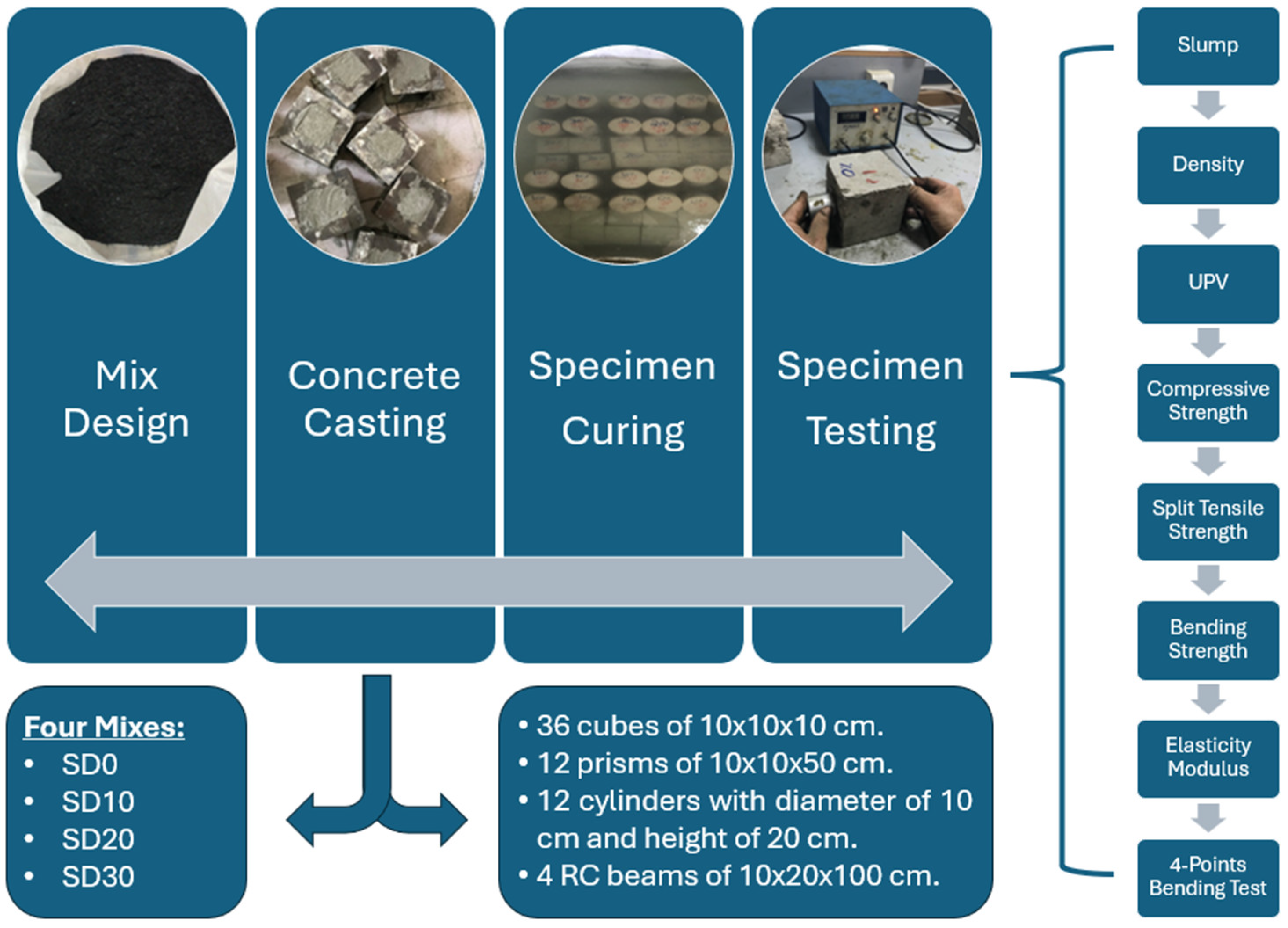
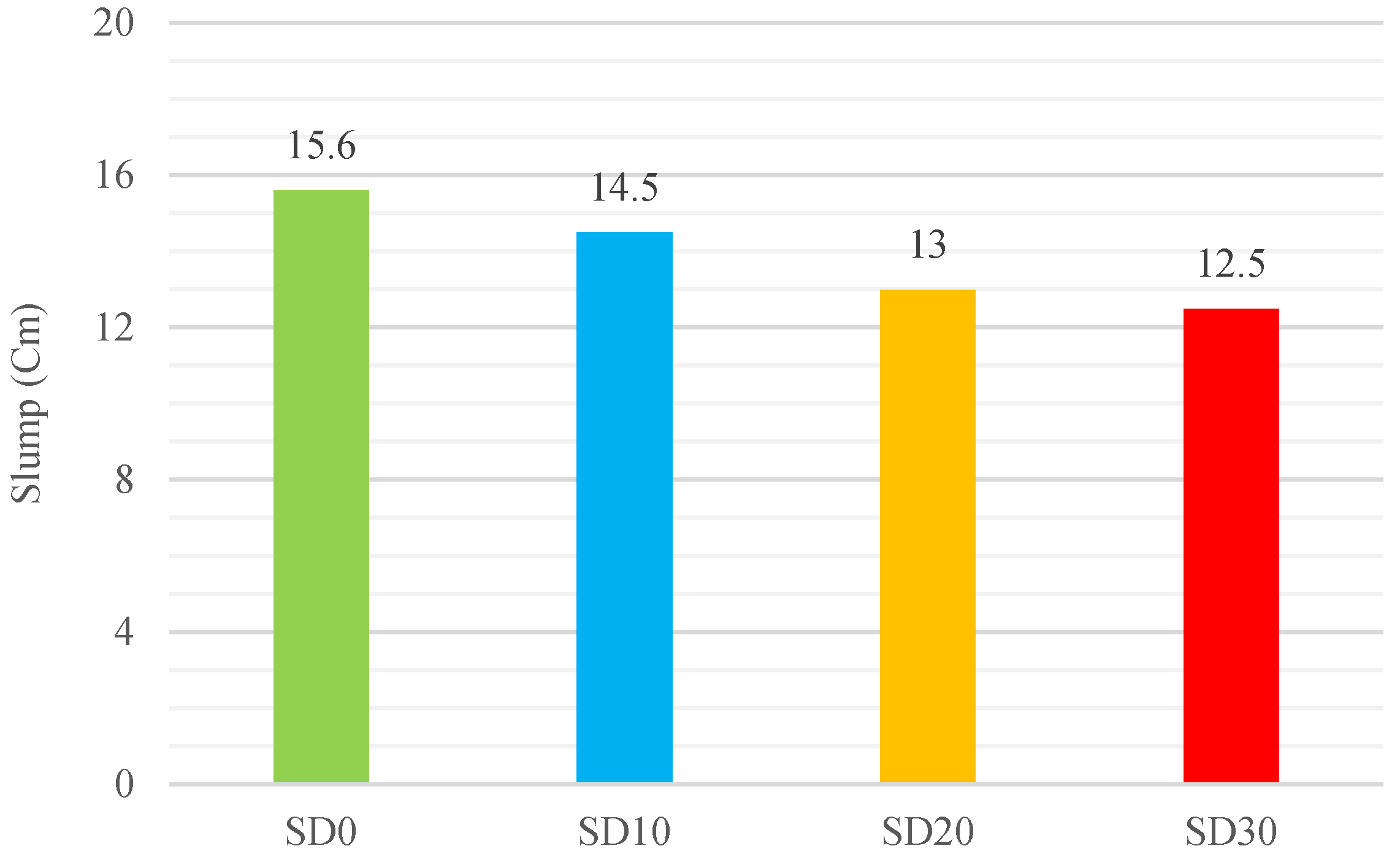
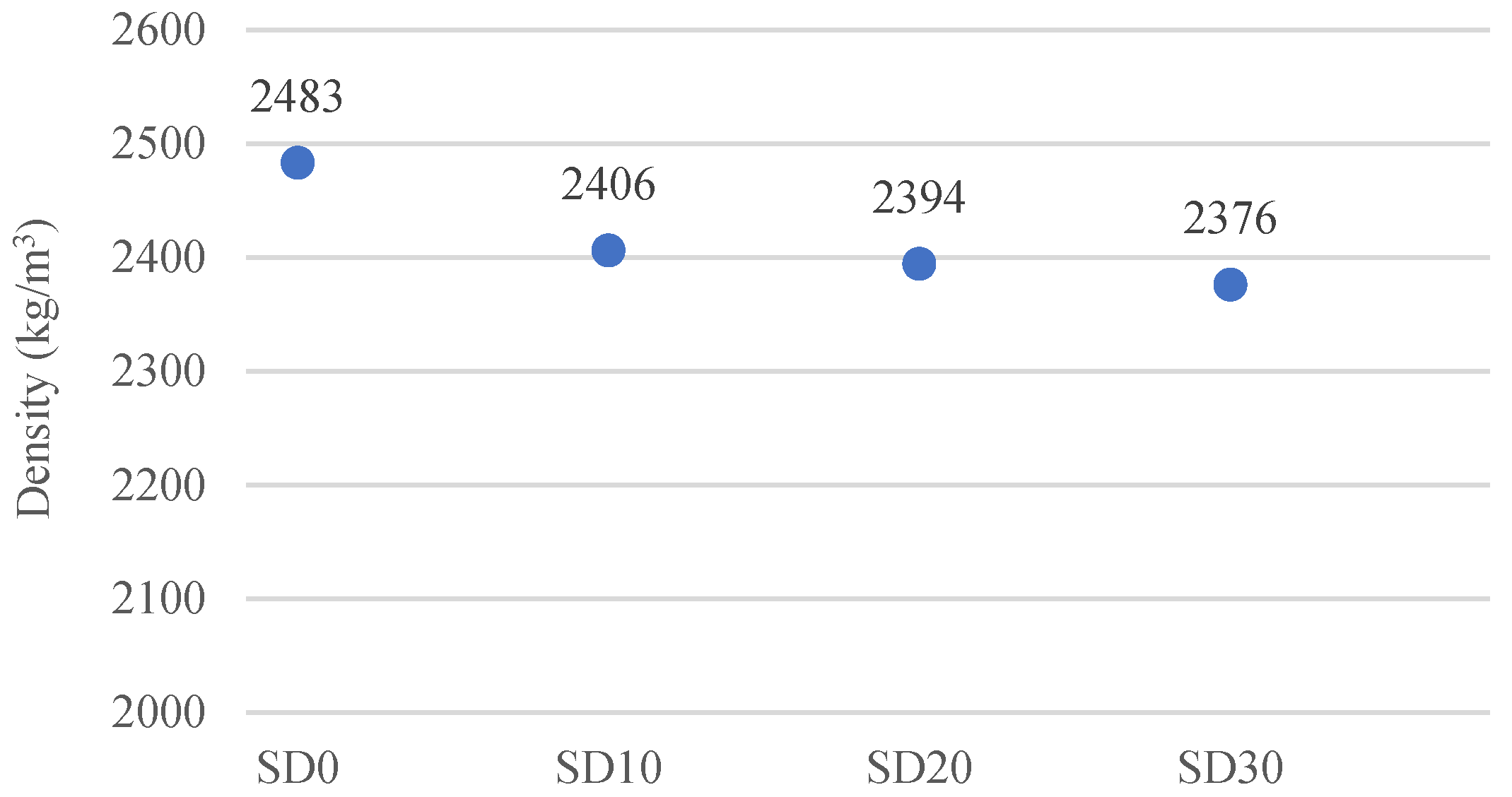
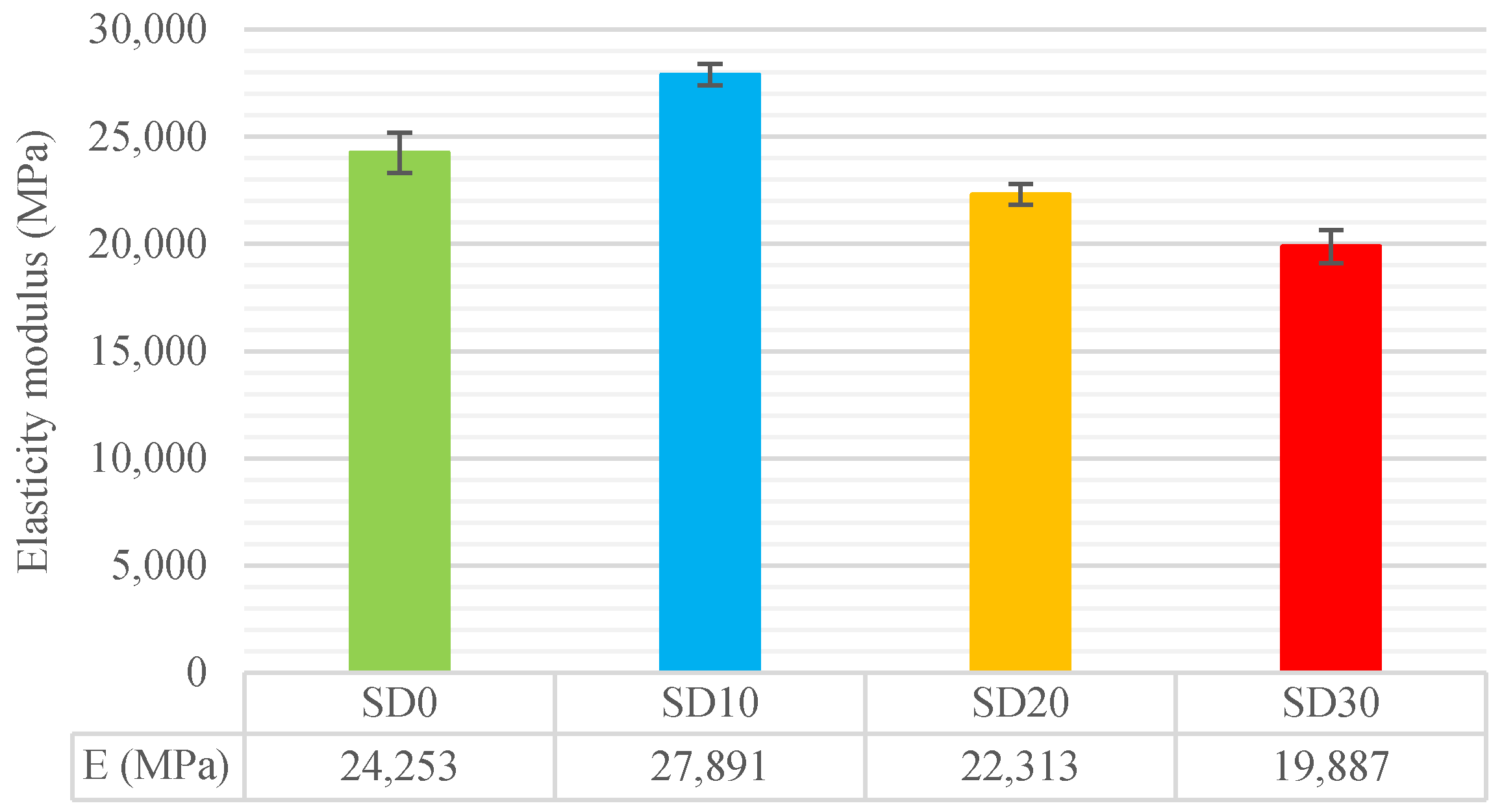

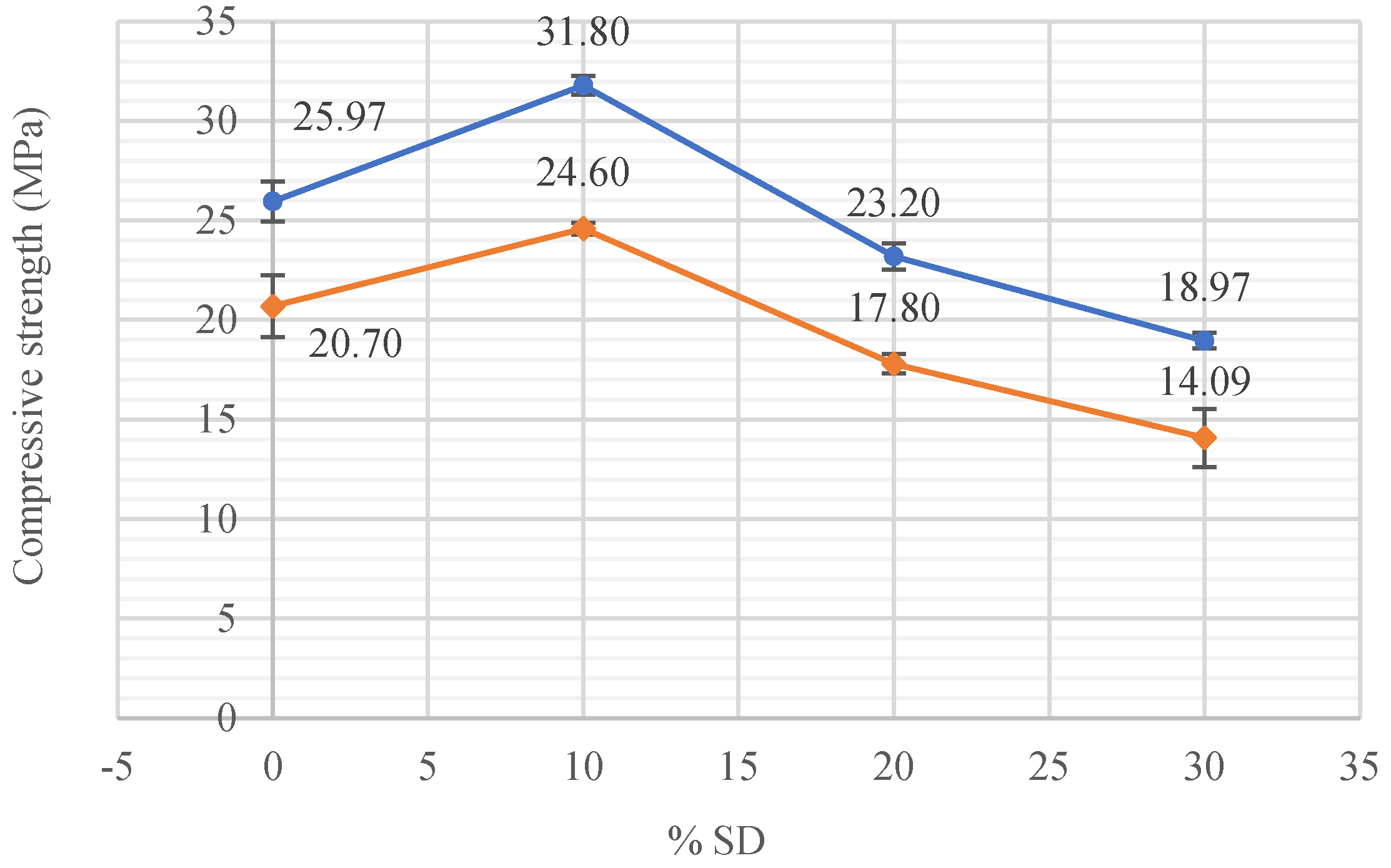
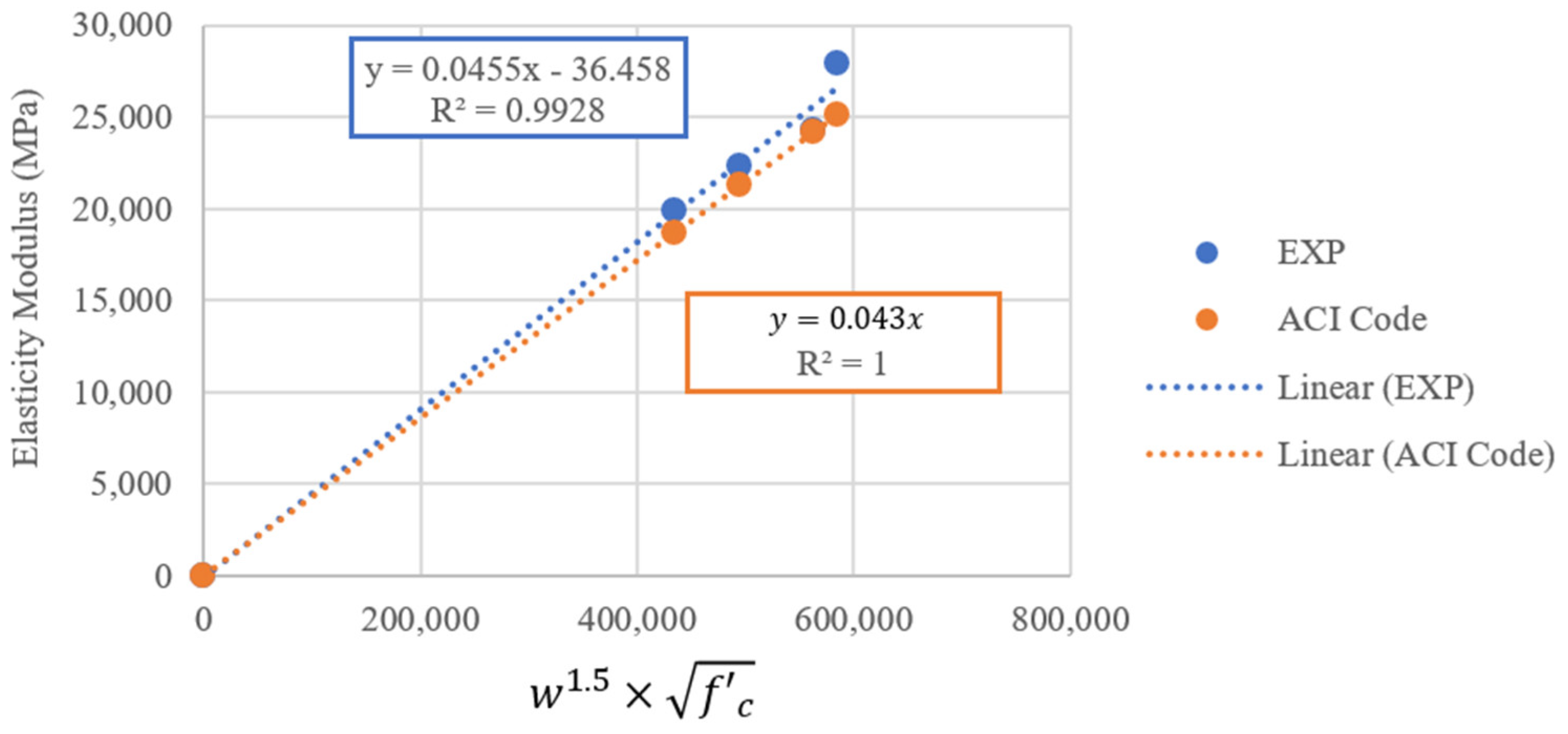
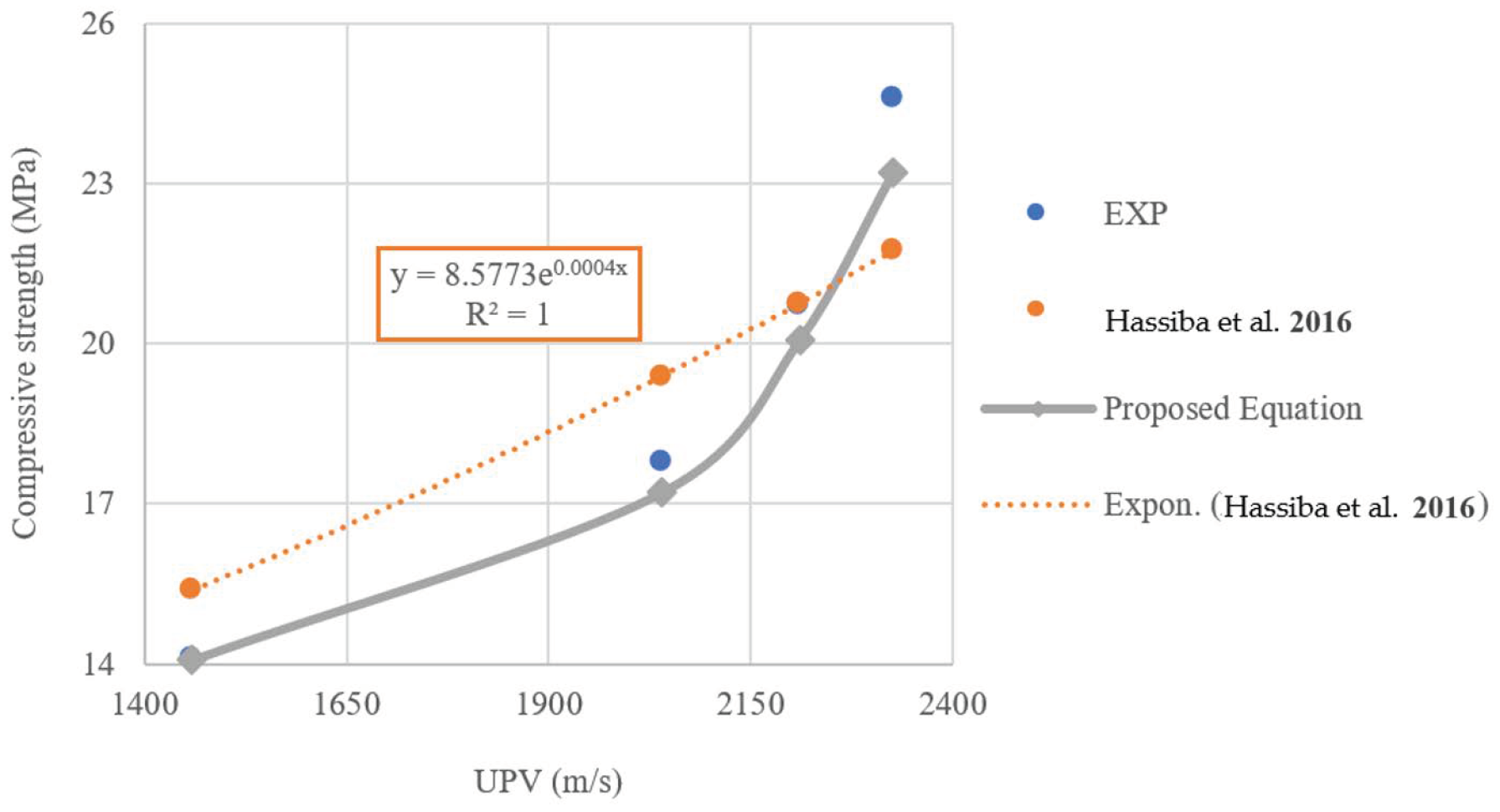

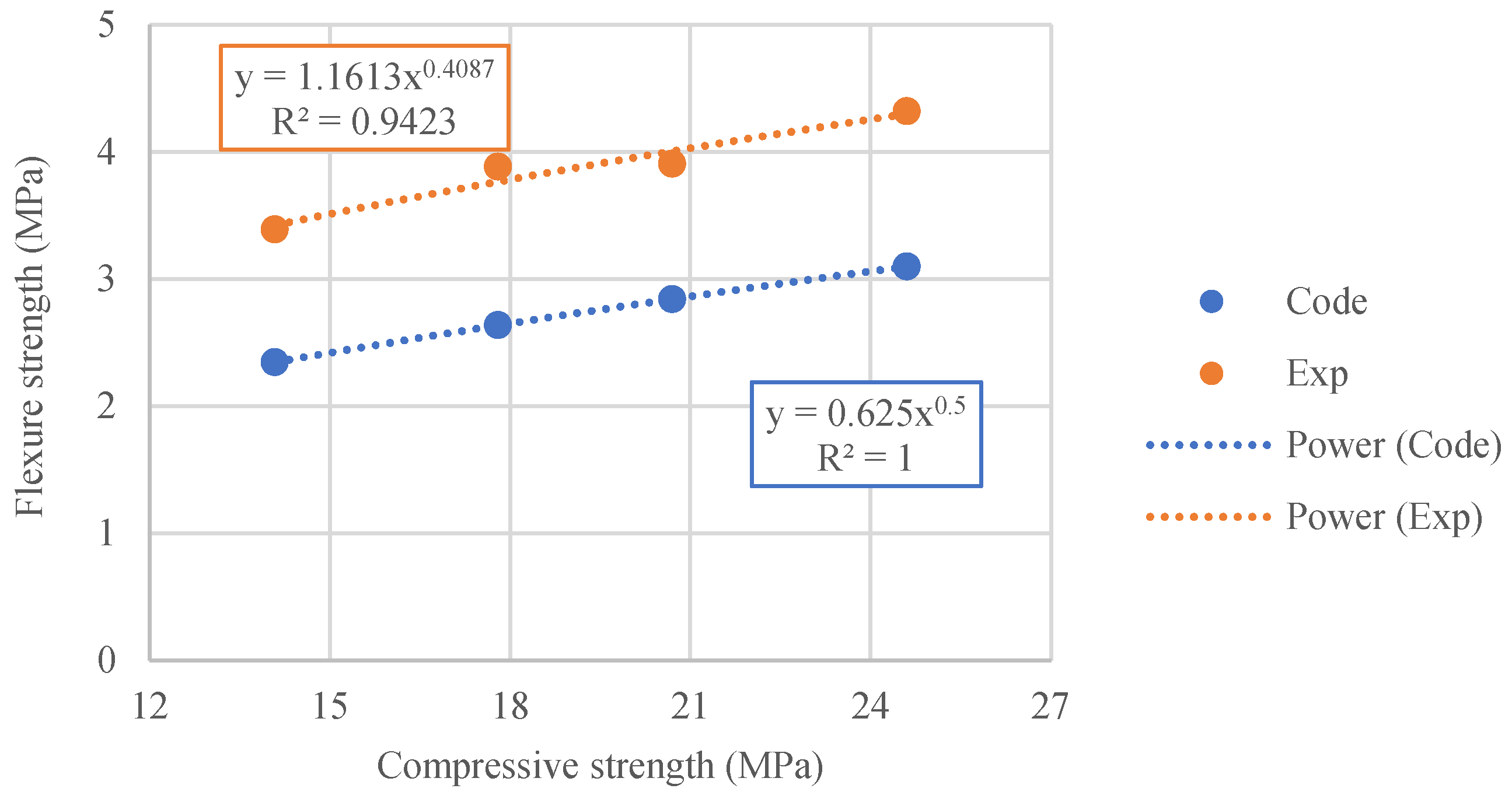
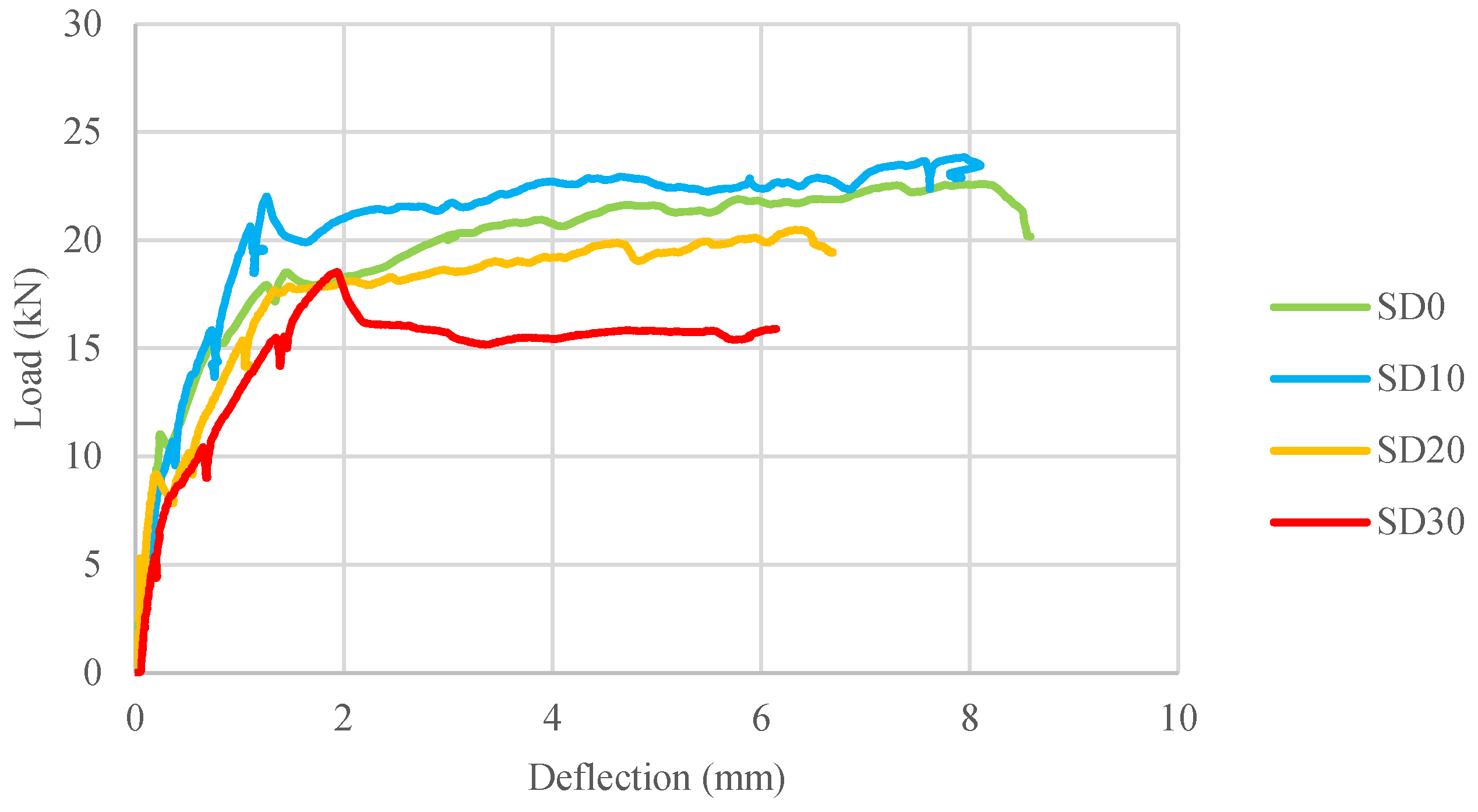
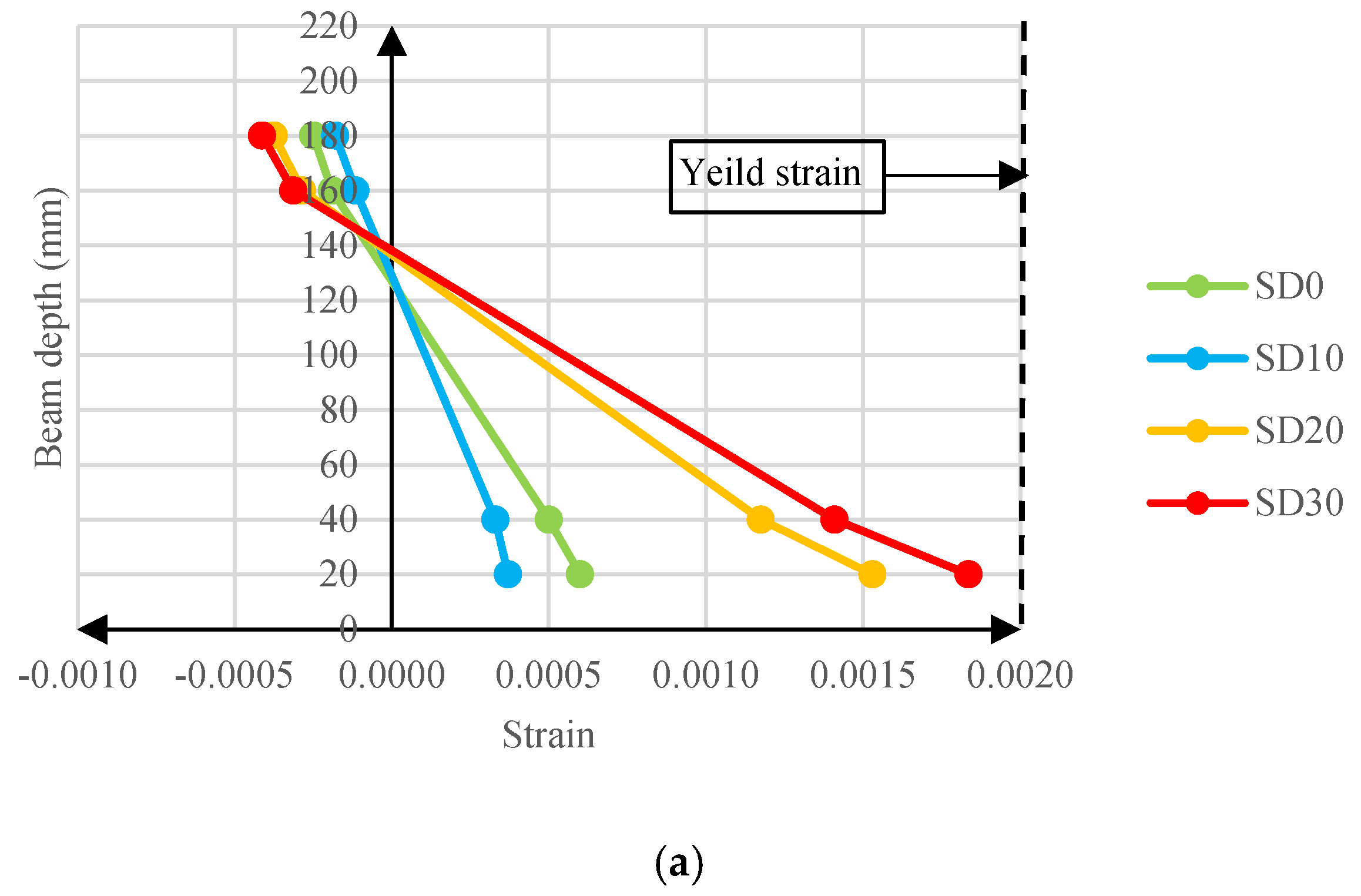
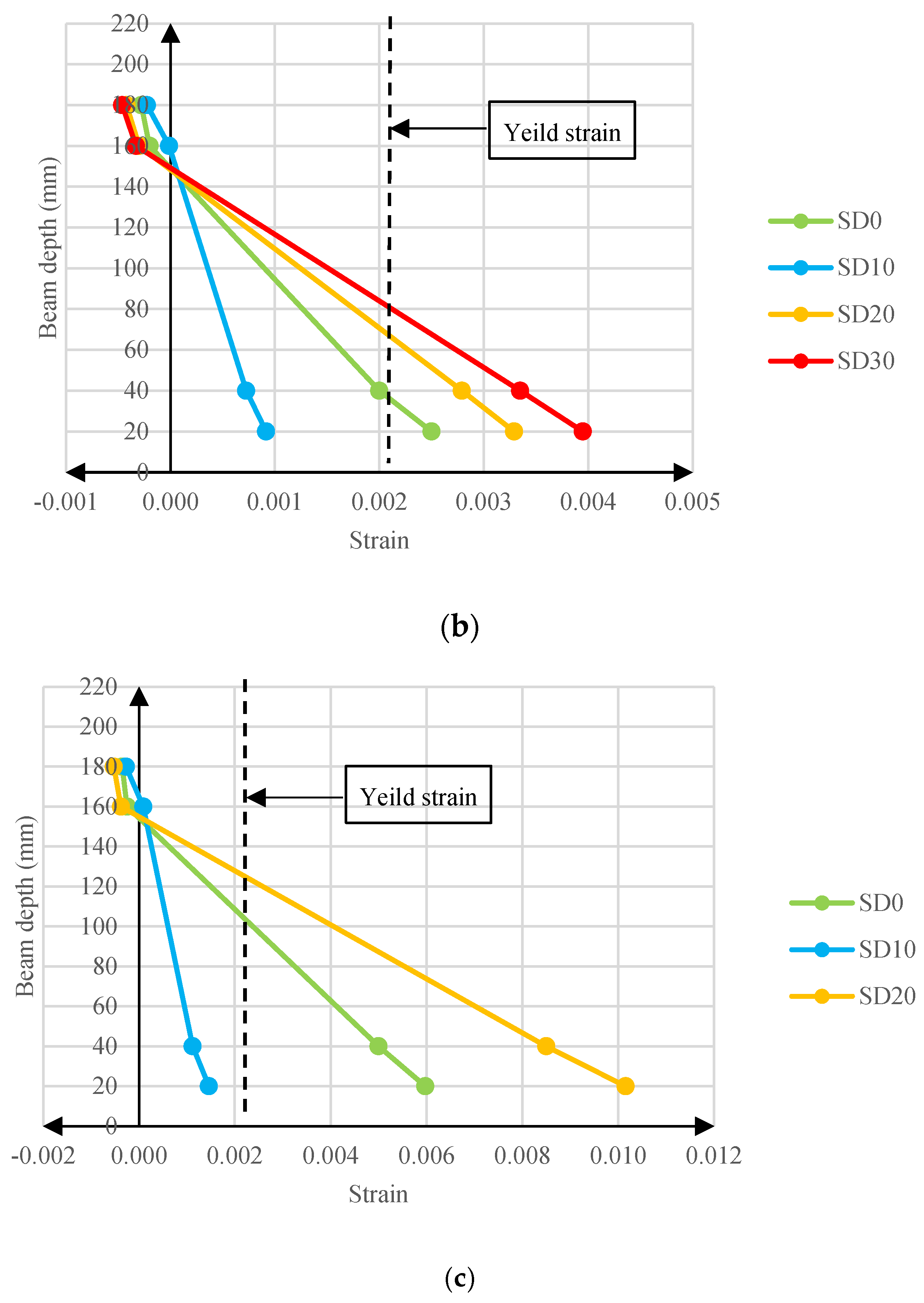
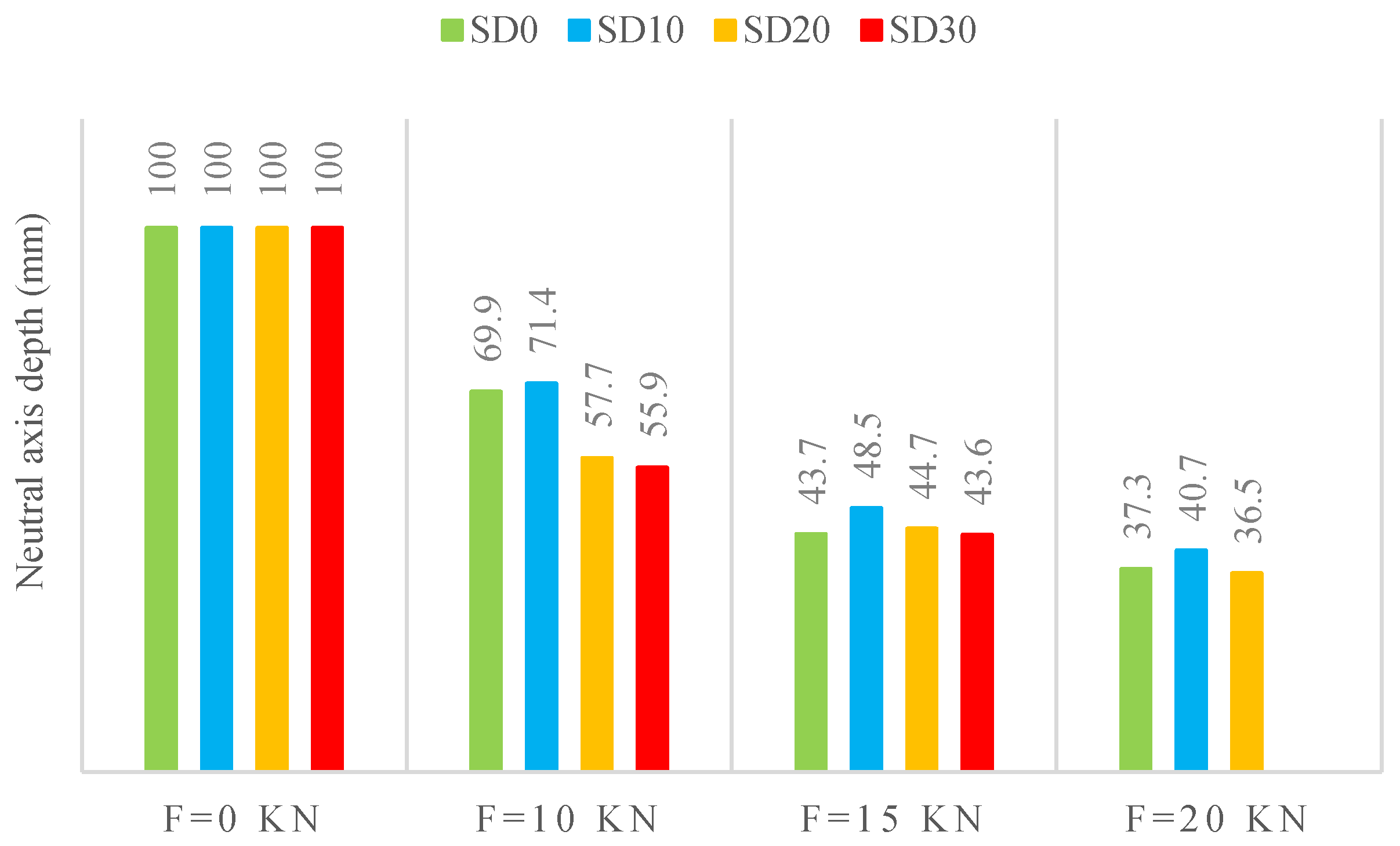

| Mix Notation | Material Composition (kg/m3) | |||||
|---|---|---|---|---|---|---|
| Cement | Sand | Gravel | Steel Dust | Water | W/C | |
| SD0 | 16.4 | 34.3 | 68.5 | 0 | 9.4 | 0.55 |
| SD10 | 14.7 | 34.3 | 68.5 | 1.6 | 9.4 | 0.55 |
| SD20 | 13.1 | 34.3 | 68.5 | 3.3 | 9.4 | 0.55 |
| SD30 | 11.5 | 34.3 | 68.5 | 4.9 | 9.4 | 0.55 |
| Specimen | f′cu (MPa) | f′c (MPa) | Ratio |
|---|---|---|---|
| SD0 | 25.9 | 20.7 | 80% |
| SD10 | 31.8 | 24.6 | 77% |
| SD20 | 23.2 | 17.8 | 77% |
| SD30 | 18.9 | 14.1 | 74% |
| Density (kg/m3) | f′c (MPa) | [Density1.5] × [f′c]0.5 | E (exp) (MPa) | E (ACI) (MPa) | ||
|---|---|---|---|---|---|---|
| SD0 | 2483.0 | 20.7 | 4.5 | 562,879.3 | 24,253.0 | 24,203.8 |
| SD10 | 2406.0 | 24.6 | 4.9 | 585,383.4 | 27,890.9 | 25,171.4 |
| SD20 | 2394.3 | 17.8 | 4.2 | 494,295.8 | 22,312.7 | 21,254.7 |
| SD30 | 2376.0 | 14.1 | 3.71 | 434,684.1 | 19,887.4 | 18,691.4 |
| UPV (m/s) | f′c (Exp) | f′c (Hassiba et al. [61]) |
|---|---|---|
| 2210 | 20.7 | 20.8 |
| 2326.6 | 24.6 | 21.8 |
| 2040 | 17.8 | 19.4 |
| 1460 | 14.1 | 15.4 |
| Mix Type | Δy a (mm) | Δm b (mm) | (δm/δy) c | Ductility Ratio Improvement | Fmax d | Peak Load Improvement |
|---|---|---|---|---|---|---|
| SD0 | 1.51 | 8.58 | 5.68 | - | 22.59 | - |
| SD10 | 1.26 | 8.10 | 6.43 | 1.13 | 23.83 | 1.05 |
| SD20 | 1.36 | 6.69 | 4.92 | 0.87 | 20.49 | 0.91 |
| SD30 | 1.94 | 6.14 | 3.17 | 0.56 | 18.52 | 0.82 |
Disclaimer/Publisher’s Note: The statements, opinions and data contained in all publications are solely those of the individual author(s) and contributor(s) and not of MDPI and/or the editor(s). MDPI and/or the editor(s) disclaim responsibility for any injury to people or property resulting from any ideas, methods, instructions or products referred to in the content. |
© 2023 by the authors. Licensee MDPI, Basel, Switzerland. This article is an open access article distributed under the terms and conditions of the Creative Commons Attribution (CC BY) license (https://creativecommons.org/licenses/by/4.0/).
Share and Cite
Jahami, A.; Younes, H.; Khatib, J. Enhancing Reinforced Concrete Beams: Investigating Steel Dust as a Cement Substitute. Infrastructures 2023, 8, 157. https://doi.org/10.3390/infrastructures8110157
Jahami A, Younes H, Khatib J. Enhancing Reinforced Concrete Beams: Investigating Steel Dust as a Cement Substitute. Infrastructures. 2023; 8(11):157. https://doi.org/10.3390/infrastructures8110157
Chicago/Turabian StyleJahami, Ali, Hussein Younes, and Jamal Khatib. 2023. "Enhancing Reinforced Concrete Beams: Investigating Steel Dust as a Cement Substitute" Infrastructures 8, no. 11: 157. https://doi.org/10.3390/infrastructures8110157







